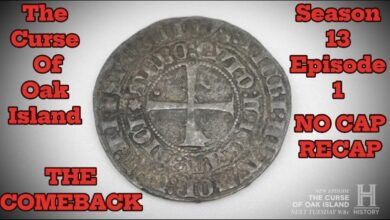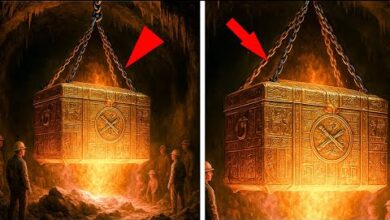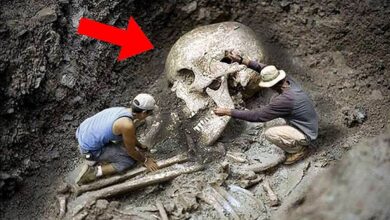The Curse Of Oak Island Season 12: The Button, the Coin and the Secret Tunnel
The Curse Of Oak Island Season 12: The Button, the Coin and the Secret Tunnel

Hey guys, what if I told you that a simple button, a mysterious coin, and an elusive secret tunnel might be the keys to unlocking one of the greatest treasure mysteries of all time? That’s right—The Curse of Oak Island is back with Season 12, Episode 4, and this episode is packed with jaw-dropping discoveries, shocking twists, and a few clues that could change everything we thought we knew about Oak Island’s legendary Money Pit.
Today we’re diving deep into the latest finds—from an ancient button to a possible coin weight that could reveal a hidden past of knights, treasure hoards, and military secrets. So buckle up, treasure hunters, because this is one episode you don’t want to miss.
Welcome back, treasure seekers—it’s time to break down Episode 4 of The Curse of Oak Island, and trust me, this one had us all on the edge of our seats. From small discoveries with big implications to a larger excavation that might just blow the whole mystery wide open, this episode had it all.
The search for Oak Island’s fabled treasure is 200 years in the making, but in this episode, it feels like the Lagina brothers and their team are closer than ever to finally cracking the code. And it all starts with an unlikely set of clues: a button, a coin, and a secret underground tunnel.
But these aren’t just random finds. Each one tells a story—and that story might just lead to buried treasure.
Let’s kick things off with the most intriguing element: the secret tunnel. The Oak Island team has been following a theory that points to the flood tunnels—the infamous underwater channels designed to flood the Money Pit with seawater whenever someone tries to dig too deep.
In this episode, the team uses maps from the 1960s, created by treasure hunter Bobby Restall, to pinpoint a potential convergence point for these flood tunnels. The idea is simple but powerful: if they can locate and block the source of the floodwater, they could finally access the treasure at the bottom of the Money Pit.
But, as always with Oak Island, it’s easier said than done. The convergence point—where multiple finger drains are believed to meet—is located at tidal level, meaning it’s underwater at high tide. This complicates things because environmental laws prevent digging below the waterline without special permits.
So what do they do? They shift their digging operation slightly inland. Using heavy-duty excavation equipment, they begin to peel back layers of earth, looking for signs of old tunnel shafts or any evidence of human-made structures. Their goal is clear: find something that connects back to the infamous flood system.
And here’s where it gets exciting—they believe they’re close. The evidence suggests they might be tapping into one of these flood channels, possibly the same one discovered by the Restalls in 1961 when they attempted to block it with concrete. If the team can find remnants of that concrete or identify a tunnel, they could be on the brink of shutting off the flood system once and for all.
That alone would be a game changer for the entire Oak Island mystery. Imagine a Money Pit without water constantly rushing in—the dream of every treasure hunter since the 1700s.
Next up is the discovery of a button. But not just any button—this small copper alloy button is found by Craig Tester and Gary Drayton while sifting through spoils from Lot 5, one of the most intriguing locations on the island.
Now I know what you’re thinking: it’s just a button—what’s the big deal? But on Oak Island, every small discovery has the potential to rewrite history.
According to Gary, this isn’t an ordinary button you’d find on a modern coat—it’s a tunic button, possibly from the late 1600s to the mid-1700s. The design suggests it belonged to someone of higher status—perhaps military, perhaps nobility, or even someone directly involved in the original creation of the Money Pit.
When the button is analyzed, it’s revealed to be a copper-iron alloy with a significant amount of lead. And here’s the kicker—there’s no sign of modern contamination. This points to one conclusion: it’s old.
This small clue could be a vital link in the chain of evidence that connects the mysterious round feature on Lot 5 to larger theories about British military involvement on Oak Island. It’s one thing to find a button—but to connect it to soldiers or high-ranking figures raises questions about who was on the island, and why.
Could they have been part of a secret mission to bury treasure? Were they part of the infamous Knights Templar?
The deeper you dig into Oak Island, the more you realize—there’s always more to the story.
Just when you thought things couldn’t get more interesting, Gary Drayton finds what might be a coin weight in the Lot 5 spoils. This find sparks a lot of speculation.
At first glance, it looks like a lead disc with a distinctive shape—the kind of shape you’d expect from a coin weight used in medieval trade. Back then, coins didn’t always have a consistent weight, so merchants used coin weights to ensure they weren’t being scammed.
Gary immediately calls it out as a possible coin weight. But when it’s brought to the Oak Island Lab, there’s some disagreement. Emma Culligan suggests it could be modern, based on its chemical composition—specifically the phosphorus content, which wasn’t common in older lead artifacts.
But here’s the thing—nothing else about Lot 5 seems modern. This creates a mystery within a mystery.
If it really is a coin weight, it could be evidence that large sums of treasure—possibly in gold—were being weighed and divided on Oak Island. Imagine the scenario: treasure hoarders—perhaps pirates or military operatives—using this tool to divide up the spoils.
Even though Emma believes the artifact might be modern, she agrees to do a laser ablation test—a process that can determine the exact age and origin of the lead. If the lead proves to be from the 1600s or earlier, it could be the strongest proof yet that Oak Island’s hidden treasure exists.
So let’s take a step back.
In one episode, we have three huge clues:
-
The button – possible military origins, hinting at soldiers, nobility, or organized treasure depositors.
-
The coin weight – a tool possibly used to divide valuable treasure.
-
The secret tunnel – evidence that they’re closer than ever to blocking the flood system.
If you’re like me, you’re already putting the pieces together. These aren’t random discoveries—this is a trail of breadcrumbs. Everything points to people of power and influence being on the island, protecting something so valuable they created an elaborate flood system to keep it hidden.
With the potential to shut down the flood tunnel and isolate the Money Pit, the stakes have never been higher.
Could this be the season where the Lagina brothers finally crack The Curse of Oak Island? Will they finally locate treasure buried for centuries?
The button, the coin weight, and the tunnel are all pointing toward one undeniable truth—they’re getting closer.
The days of digging blind are over. With every discovery, the mystery becomes clearer. And if you’re a fan of this show, you know that it only takes one breakthrough find to change everything.
The journey to uncover Oak Island’s elusive secrets is a test of resilience, ingenuity, and patience.
As the team continues drilling Borehole FN15.5, the excitement lingers despite the absence of immediate revelations. Each core sample brings a mix of hope and uncertainty—but the unwavering belief that they are on the brink of something extraordinary keeps the energy high.
The Golden Egg Zone, believed to be a high-potential area for treasure or critical evidence, serves as a symbol of the team’s enduring faith in the mission.
The convergence of history, science, and intuition is evident in every step of their excavation process. While their findings in FN5.5 were inconclusive, the team remains committed to exploring the adjacent areas.
As Rick Lagina often reminds his colleagues: the search is not just about treasure—it’s about solving one of history’s greatest mysteries.
This perspective fuels their determination, even in moments of frustration.
The discoveries on Lot 5, combined with ongoing efforts at Smith’s Cove and the Money Pit, underscore the interconnected nature of Oak Island’s mysteries. Each piece of evidence adds a layer to the overarching narrative—much like assembling a jigsaw puzzle with missing pieces.
The team’s collaboration—despite differing theories and interpretations—exemplifies the unity needed to solve such a complex mystery.
From 14th-century tokens to ancient buttons, every artifact is a breadcrumb leading closer to the truth. The historical significance of these items suggests that Oak Island was more than a random location—it was a planned, deliberate site of activity, possibly involving treasure or artifacts of great value.
As the team reflects on their progress, one thing remains clear: Oak Island’s story is far from over.
Whether it’s through the discovery of a tunnel, the identification of a significant artifact, or the ultimate unearthing of treasure—the journey is as important as the destination.
The team’s efforts symbolize a relentless pursuit of knowledge, a willingness to embrace uncertainty, and a belief in the extraordinary.
With every dig, drill, and discovery, they edge closer to unraveling the centuries-old mystery that has captivated millions.
The button, the coin weight, and the secrets buried beneath Smith’s Cove may well be the missing pieces of Oak Island’s puzzle—waiting to reveal their secrets to those who dare to seek them.








